Related Research Articles

The Burgess Shale is a fossil-bearing deposit exposed in the Canadian Rockies of British Columbia, Canada. It is famous for the exceptional preservation of the soft parts of its fossils. At 508 million years old, it is one of the earliest fossil beds containing soft-part imprints.
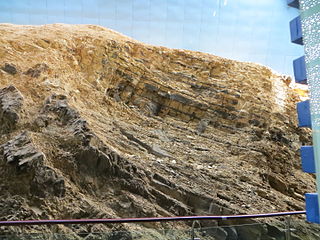
The Maotianshan Shales (帽天山页岩) are a series of Early Cambrian sedimentary deposits in the Chiungchussu Formation, famous for their Konservat Lagerstätten, deposits known for the exceptional preservation of fossilized organisms or traces. The Maotianshan Shales form one of some forty Cambrian fossil locations worldwide exhibiting exquisite preservation of rarely preserved, non-mineralized soft tissue, comparable to the fossils of the Burgess Shale of British Columbia, Canada. They take their name from Maotianshan Hill in Chengjiang County, Yunnan Province, China.

Opabinia regalis is an extinct, stem group arthropod found in the Middle Cambrian Burgess Shale Lagerstätte of British Columbia. Opabinia was a soft-bodied animal, measuring up to 7 cm in body length, and its segmented trunk had flaps along the sides and a fan-shaped tail. The head shows unusual features: five eyes, a mouth under the head and facing backwards, and a clawed proboscis that probably passed food to the mouth. Opabinia probably lived on the seafloor, using the proboscis to seek out small, soft food. Fewer than twenty good specimens have been described; 3 specimens of Opabinia are known from the Greater Phyllopod bed, where they constitute less than 0.1% of the community.

Marrella is an extinct genus of marrellomorph arthropod known from the middle Cambrian Burgess Shale of British Columbia. It is the most common animal represented in the Burgess Shale, with tens of thousands of specimens collected. Much rarer remains are also known from deposits in China.

Pikaia gracilens is an extinct, primitive chordate animal known from the Middle Cambrian Burgess Shale of British Columbia. Described in 1911 by Charles Doolittle Walcott as an annelid, and in 1979 by Harry B. Whittington and Simon Conway Morris as a chordate, it became "one of the most famous early chordate fossils," or "famously known as the earliest described Cambrian chordate". It is estimated to have lived during the latter period of the Cambrian explosion. Since its initial discovery, more than a hundred specimens have been recovered.

Sidneyia is an extinct arthropod known from fossils found from the Early to the Mid Cambrian of China and the Mid Cambrian Burgess Shale of British Columbia, Canada.
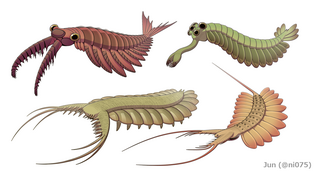
Dinocaridida is a proposed fossil taxon of basal arthropods that flourished in the Cambrian period with occasional Ordovician and Devonian records. Characterized by a pair of frontal appendages and series of body flaps, the name of Dinocaridids refers to the suggested role of some of these members as the largest marine predators of their time. Dinocaridids are occasionally referred to as the 'AOPK group' by some literatures, as the group compose of Radiodonta, Opabiniidae, and the "gilled lobopodians" Pambdelurion and Kerygmachelidae. It is most likely paraphyletic, with Kerygmachelidae and Pambdelurion more basal than the clade compose of Opabiniidae, Radiodonta and other arthropods.

Anomalocaris is an extinct genus of radiodont, an order of early-diverging stem-group arthropods.
The Burgess Shale of British Columbia is famous for its exceptional preservation of mid-Cambrian organisms. Around 69 other sites have been discovered of a similar age, with soft tissues preserved in a similar, though not identical, fashion. Additional sites with a similar form of preservation are known from the Ediacaran and Ordovician periods.
A number of assemblages bear fossil assemblages similar in character to that of the Burgess Shale. While many are also preserved in a similar fashion to the Burgess Shale, the term "Burgess Shale-type fauna" covers assemblages based on taxonomic criteria only.
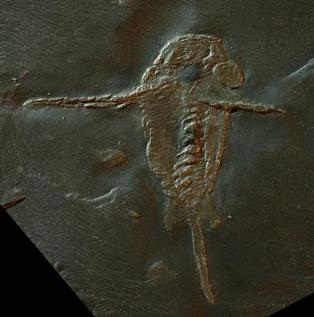
Schinderhannes bartelsi is a species of hurdiid radiodont (anomalocaridid) known from one specimen from the lower Devonian Hunsrück Slates. Its discovery was astonishing because previously, radiodonts were known only from exceptionally well-preserved fossil beds (Lagerstätten) from the Cambrian, 100 million years earlier.
The fossils of the Burgess Shale, like the Burgess Shale itself, are fossils that formed around 505 million years ago in the mid-Cambrian period. They were discovered in Canada in 1886, and Charles Doolittle Walcott collected over 65,000 specimens in a series of field trips up to the alpine site from 1909 to 1924. After a period of neglect from the 1930s to the early 1960s, new excavations and re-examinations of Walcott's collection continue to reveal new species, and statistical analysis suggests that additional discoveries will continue for the foreseeable future. Stephen Jay Gould's 1989 book Wonderful Life describes the history of discovery up to the early 1980s, although his analysis of the implications for evolution has been contested.

Vetulicola cuneata is a species of extinct animal from the Early Cambrian Chengjiang biota of China. It was described by Hou Xian-guang in 1987 from the Lower Cambrian Chiungchussu Formation, and became the first animal under an eponymous phylum Vetulicolia.
The Phyllopod bed, designated by USNM locality number 35k, is the most famous fossil-bearing member of the Burgess Shale fossil Lagerstätte. It was quarried by Charles Walcott from 1911–1917, and was the source of 95% of the fossils he collected during this time; tens of thousands of soft-bodied fossils representing over 150 genera have been recovered from the Phyllopod bed alone.
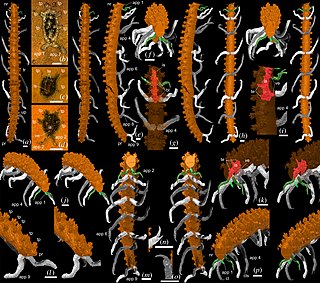
Thanahita is a genus of extinct lobopodian and known from the middle Silurian Herefordshire Lagerstätte at the England–Wales border in UK. It is monotypic and contains one species, Thanahita distos. Discovered in 2018, it is estimated to have lived around 430 million years ago and is the only known extinct lobopodian in Europe, and the first Silurian lobopodian known worldwide.

Hallucigeniidae is a family of extinct worms belonging to the group Lobopodia that originated during the Cambrian explosion. It is based on the species Hallucigenia sparsa, the fossil of which was discovered by Charles Doolittle Walcott in 1911 from the Burgess Shale of British Columbia. The name Hallucigenia was created by Simon Conway Morris in 1977, from which the family was erected after discoveries of other hallucigeniid worms from other parts of the world. Classification of these lobopods and their relatives are still controversial, and the family consists of at least four genera.

Coalbrookdale Formation, earlier known as Wenlock Shale or Wenlock Shale Formation and also referred to as Herefordshire Lagerstätte in palaeontology, is a fossil-rich deposit (Konservat-Lagerstätte) in Powys and Herefordshire at the England–Wales border in UK. It belongs to the Wenlock Series of the Silurian Period within the Homerian Age. It is known for its well-preserved fossils of various invertebrate animals many of which are in their three-dimensional structures. Some of the fossils are regarded as earliest evidences and evolutionary origin of some of the major groups of modern animals.
Carbotubulus is a genus of extinct worm belonging to the group Lobopodia and known from the Carboniferous Carbondale Formation of the Mazon Creek area in Illinois, US. A monotypic genus, it contains one species Carbotubulus waloszeki. It was discovered and described by Joachim T. Haug, Georg Mayer, Carolin Haug, and Derek E.G. Briggs in 2012. With an age of about 300 million years, it is the first long-legged lobopodian discovered after the period of Cambrian explosion.

This is a list of the biota of the Burgess Shale, a Cambrian lagerstätte located in Yoho National Park in Canada.
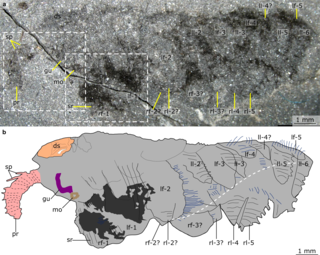
Mieridduryn is a genus of extinct dinocaridid arthropod that lived during the Middle Ordovician of what is now the United Kingdom. This animal was described in 2022 based on a singular fossil found in Castle Bank, a Burgess shale type lagerstätte located in the country of Wales. This animal's taxonomic affinities are somewhat unclear, but there are some hypotheses. One is that this animal represents a new grade of stem-euarthropods that evolved features similar to the Cambrian aged opabiniids. Another is that if the features seen in Mieridduryn are convergent, and not homologous, to those seen in radiodonts, then this animal represents a late surviving opabiniid.
References
- 1 2 "BRIGGS, Prof. Derek Ernest Gilmor". Who's Who 2014, A & C Black, an imprint of Bloomsbury Publishing plc, 2014; online edn, Oxford University Press.(subscription required)
- 1 2 "EC/1999/04: Briggs, Derek Ernest Gilmor". London: The Royal Society. Archived from the original on 29 September 2018.
- 1 2 Boyle Medal Laureates Royal Dublin Society
- ↑ "Curriculum vitae: Derek E.G. Briggs" (PDF). people.earth.yale.edu. Yale University. 2016. Retrieved 6 April 2016.
- ↑ Briggs, Derek E. G. (2014). "Adolf Seilacher (1925–2014) Palaeontologist who pioneered analysis of trace fossils". Nature. 509 (7501): 428. Bibcode:2014Natur.509..428B. doi: 10.1038/509428a . PMID 24848054.
- ↑ Derek Briggs's publications indexed by the Scopus bibliographic database. (subscription required)
- ↑ Briggs, D. E. G. (2003). "The role of decay and mineralization in the preservation of soft-bodied fossils". Annual Review of Earth and Planetary Sciences. 31 (31): 275–301. Bibcode:2003AREPS..31..275B. doi:10.1146/annurev.earth.31.100901.144746.
- ↑ Briggs, D. E. G.; Kear, A. J. (1993). "Fossilization of Soft Tissue in the Laboratory". Science. 259 (5100): 1439–42. Bibcode:1993Sci...259.1439B. doi:10.1126/science.259.5100.1439. PMID 17801278. S2CID 43188896.
- ↑ Briggs, D. E. G.; Fortey, R. A.; Wills, M. A. (1992). "Morphological Disparity in the Cambrian". Science. 256 (5064): 1670–3. Bibcode:1992Sci...256.1670B. doi:10.1126/science.256.5064.1670. PMID 17841089.
- ↑ Stankiewicz, B. A. (1997). "Preservation of Chitin in 25-Million-Year-Old Fossils". Science. 276 (5318): 1541–1543. doi:10.1126/science.276.5318.1541.
- ↑ Briggs, D. E.; Fortey, R. A. (1989). "The early radiation and relationships of the major arthropod groups". Science. 246 (4927): 241–3. Bibcode:1989Sci...246..241B. doi:10.1126/science.246.4927.241. PMID 17839017. S2CID 35322293.
- ↑ Orr, P. J.; Briggs, D. E. G.; Kearns, S. L. (1998). "Cambrian Burgess Shale Animals Replicated in Clay Minerals". Science. 281 (5380): 1173–1175. Bibcode:1998Sci...281.1173O. doi:10.1126/science.281.5380.1173. PMID 9712577.
- ↑ Briggs, D. E. G. (1999). "Molecular taphonomy of animal and plant cuticles: selective preservation and diagenesis". Philosophical Transactions of the Royal Society B: Biological Sciences. 354 (1379): 7–17. doi:10.1098/rstb.1999.0356. PMC 1692454 .
- ↑ Briggs, D. E. G. (2013). "A mosquito's last supper reminds us not to underestimate the fossil record". Proceedings of the National Academy of Sciences. 110 (46): 18353–18354. Bibcode:2013PNAS..11018353B. doi: 10.1073/pnas.1319306110 . PMC 3832008 . PMID 24187151.
- ↑ Bryson, Bill (2004). A short history of nearly everything. London: Black Swan. p. 397. ISBN 978-1-40909-548-4.
- ↑ Briggs, Derek Ernest Gilmour (1976). Arthropods from the Burgess Shale, Middle Cambrian, Canada (PhD thesis). University of Cambridge.
- ↑ Morris, Simon Conway (1998). The Crucible of Creation : the Burgess Shale and the Rise of Animals. Oxford, UK: Oxford University Press. p. vii. ISBN 978-0-1985-0256-2.
- ↑ Bhushan A (27 November 2007). "'Visionary' Briggs to lead, expand Peabody". yaledailynews.com. Yale Daily News. Retrieved 13 July 2013.
- ↑ Yale News (20 November 2007). "Derek Briggs Appointed Next Director of Yale's Peabody Museum of Natural History". news.yale.edu. Yale University. Retrieved 13 July 2013.
- ↑ Yale News (8 February 2011). "Derek Briggs is named the Hutchinson Professor of Geology and Geophysics". news.yale.edu. Yale University. Retrieved 13 July 2013.
- ↑ Derek E. G. Briggs, D. H. Erwin, and F. J. Collier. The fossils of the Burgess Shale. ISBN 156098659X
- ↑ Derek E. G. Briggs, C. Bartels, and G. Brassel. The fossils of the Hunsrück Slate. ISBN 0521117070
- ↑ Derek E. G. Briggs and Peter R. Crowther, eds. (2003). Palaeobiology II. Malden, Massachusetts: Blackwell Publishing. ISBN 0-632-05147-7 and ISBN 0-632-05149-3.
- ↑ Derek E.G. Briggs, Nicholas H. Barton, Jonathan A. Eisen, David B. Goldstein, and Nipam H. Patel. Evolution. ISBN 9780879696849
- ↑ "Medal and Award Winners List". Palaeontological Association. Retrieved 29 April 2020.